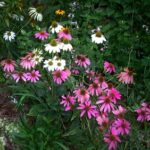Flower gardens need not be restricted to spring and summer enjoyment. There are many plants that will bloom throughout the fall season as well. In fact, fall flower gardens not only provide extended blooming time, but sources like foliage, berries, bark, and other focal points can also provide additional color and interest. Additionally, these beautiful fall gardens offer food and shelter to wildlife at a time when it may otherwise be scarce.
The best time to plant a fall flower garden is generally late September through early October, depending on where you live. Checking hardiness zones for your particular area beforehand is especially helpful, and many resources are available which provide this information. Many cool-season annuals work well in a fall flower garden. Some of these could include snapdragons, pot marigolds, and pansies. These types of annuals are available in a variety of colors as well so finding one that suits your taste shouldn’t be a problem. Provided the fact that flowers are deadheaded within a timely matter, many of these plants will bloom throughout the fall. Bulbs such as lilies, autumn crocus, and cyclamen also do quite nicely in a fall flower garden. Numerous perennials also bloom during autumn and provide additional interest throughout winter too. Some of the most popular fall-blooming perennials include asters, chrysanthemums, and goldenrod. These should be planted in early fall.
Asters and mums produce compact plants with continual blooming in the fall flower garden. Both types of flowers are available in a variety of colors. Asters can range in color from purple and blue to pink and white. Chrysanthemums consist of burgundy, red, orange, pink, lavender, bronze, yellow, and white. When placed in mass plantings within the fall flower garden, these flowers will produce an intense, colorful show. Goldenrod is extremely hardy; and during autumn, this plant will provide beautiful gold and yellow blooms. For intense color in your fall garden, consider using red and lavender colored plants. These could include red wax begonias, viburnum berries, red mums mixed with lavender asters and mistflowers. For those who prefer a more subtle look, choose gold and lavender instead. Use yellow or bronze-colored mums, pampas grass, and goldenrod mixed with lavender asters or purple coneflowers.
Trees and shrubs help to give the fall flower garden additional shape, texture, and color. Once flowering bulbs and other plants have begun to fade, the intense shades of leaf color, ranging from yellow and orange to red and purple, create a stunning display. Japanese maples and witch hazels are commonly seen in fall flower gardens and provide brilliant fall foliage. Most of us think of the blooms as the major attraction on a rose bush. Did you know there are many varieties of roses that offer colorful fall foliage as well? A couple of rose shrubs that look perfect in the fall flower garden are the Virginia Rose and Blue Rambler. Leaf color can be further enhanced by placing these among a background of evergreens. When choosing trees and shrubs for the fall flower garden, you should also consider the characteristics from the bark as well. Those which peel or provide unusual color can be quite appealing in a fall flower garden.
Ornamental grasses reach their peak during fall and can also add texture, volume, and color to the fall flower garden. Many of these develop seed heads after flowering has ceased, and their foliage will turn golden-brown. Berries also ripen in the fall and supply additional color and interest with shades of red, purple, and yellow. There are many groundcovers which produce berries and have colorful leaves, and some of the evergreen varieties make attractive additions too. Ornamental plants can complement other fall-blooming plants as well. Ornamental kales range in color from white to red with green to purple foliage. Ornamental peppers produce bright red fruits that cover the plant and create a unique presence in the fall flower garden.
Additional features to consider in a fall flower garden include statues, ponds, stones, arbors, etc. These can further intensify the area by providing supplementary height and focal interest. Creating a fall flower garden can extend seasonal interest beyond the spring and summer months; and many plants in these gardens will continue to thrive each following year to come.



